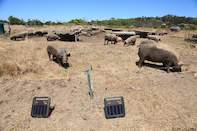Karoo sheep farmer André Lund and Zimbabwean cattle farmer Johann Zietsman are seen as the pioneers of high density and ultra high density grazing in South Africa.

The grazing management method mimics the way in which large numbers of game, such as the wildebeest, migrate over large tracks of land, such as the Serengeti, with the animals only returning to the same spot once the land has recovered.
The animals improve soil fertility by trampling plant material that has not been eaten into the grass, while covering the area with their manure and urine.
Livestock Application
Instead of merely moving livestock from one big camp to another, high density grazing entails the grouping of high numbers of livestock numbers to graze small areas of land over short grazing periods. The animals are only sent back to the same spot of land once the forage has recovered.
The stocking density, or number of animals grouped together, will depend on the type of animal in the production system, with the higher the stocking density the shorter the grazing period, the higher the amount of forage being trampled and the more uniform the urine/manure distribution. The main difference between high and ultra-high density grazing therefore being that higher stocking densities are used.
Grain SA advises farmers to consider the live weight of animals to calculate the area that should be grazed each day, as animals usually need to eat about three percent of their live weight. The ideal is for at least 50% of the forage to be trampled into the soil surface. In other words, the animals should eat the most nutritious lush tops of the plant and the energy rich seeds, while the rest of the forage will be trampled into the soil.
Animal movement in this system is usually controlled by electric fencing, as camps and movable enclosures become too expensive over such small areas of land.
Animal’s density should preferably be lowered during wet spells or the animals should be moved to other parts of the farm to avoid compaction, while forage can be baled if the cover crop outgrows the livestock demand.
The best results are achieved where a wide variety of crops, such as warm and cool season broadleaves and grasses are incorporated into the system. Having a wide variety of plants helps to create a favourable ecosystem for organisms above and below the soil, with each plant also bringing its own eco-services and production benefits.
Benefits
Having the pastures well trampled and soiled with urine and manure, will help to improve soil quality and reduce fertiliser costs. The large number of animals feeding the pasture also helps to eliminate weed problems. Besides this the system improves forage quality and pasture productivity, while reducing selective grazing.
The biggest drawback with the system is that it is much more labour intensive and requires much better management skills than when animals are simply moved from one large camp to another.